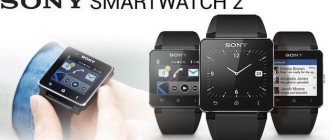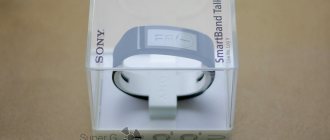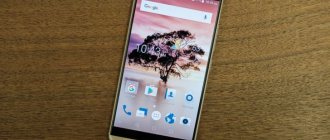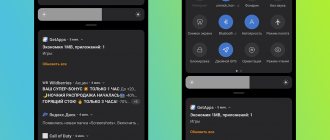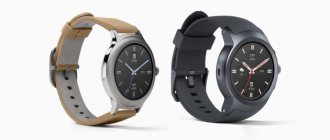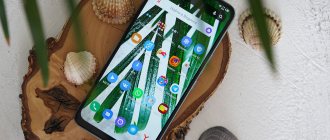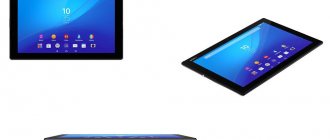Is it worth spending money on Sony Smart Watch 3? Every potential device buyer is interested in this question. You must have already studied the reviews about the accessory, but there was not enough information in them. In this case, we recommend reading our review to find out what a “smart watch” from Sony is.
The review covers almost everything about the accessory. You will learn about what comes with the device. Familiarize yourself with the appearance of the watch and find out the location of the control elements (in simple terms, buttons). Without fail, we will talk about the functionality of the accessory and partly about third-party applications that can be installed on it.
If you are thinking about purchasing a third generation Smart Watch from Sony, be sure to read all the information below. In the text, we will talk in detail about all the advantages and disadvantages of the Sony Smart Watch 3 in more detail than the reviews written by customers. Enjoy reading!
What's included?
In the accessory package you will find:
- Directly the clock module;
- Wireless strap;
- USB to microUSB cable;
- Documents and operating instructions.
The watch is sold in a nice transparent box, so there is no shame in presenting it as a gift.
Accessory dimensions, design, controls
The design of Sony products is very recognizable. And numerous user reviews indicate that the external design of devices from the Japanese manufacturer is truly of high quality. However, if we talk specifically about Sony Smart Watch 3, there is nothing special in the appearance of the accessory. Compared to the LG G Watch or Samsung Galaxy Gear, Sony's smartwatches don't stand out at all.
In design, everything is both easy and complex. It’s difficult because each user has their own taste, and some may like the accessory, while others may not. And it’s easy because to understand whether you like the design, you just need to look at the watch.
At the moment, the smart accessory from Sony is available in three color variations: black, lemon and white. If desired, you can purchase a pink strap separately.
There is also an option with a metal strap. However, its price is correspondingly higher. It is worth noting that with an aluminum strap, Sony Smart Watch 3 looks much more solid and resembles the company’s corporate style. And customer reviews say that metal fits the watch module much better.
As a standard, the accessory strap is made of rubberized material. It feels quite tolerable on the wrist, but do not tighten it too tightly. The clock module is easily removed, which allows you to comfortably recharge the device.
The watch module at the back is made of steel, and the front surface is covered with protective glass. On the right you will find the power button for the accessory, and in the back there is a plug for the microUSB input. The accessory has an IP68 protection standard, guaranteeing its protection from dust and moisture. You can even swim with the watch (in theory), but you shouldn’t get it wet on purpose. It is enough to close the cover of the Sony Smart Watch 3, and the device will lose its former functionality. Read the reviews of people who swam with the accessory and you will understand everything.
The size of the accessory is 36x51x10 millimeters, and the strap together with the module weighs about 80 grams. The dimensions of the module are quite large, and for certain people this may limit the mobility of the wrist, but everything is individual here. On the contrary, many people praise the watch for its similar size and do not experience any discomfort while using the device. To understand whether an accessory is right for you, you need to wear it for at least a week.
Smartwatch Sony SmartWatch 3
Another model on Android Wear - with GPS and an unusual screen
A little over a year ago, we told you about the Sony SmartWatch 2. At that time, it was one of the most interesting and stylish models of its kind, and Sony looked like one of the leaders in the emerging smartwatch market. But in the first half of 2014, Samsung released several very worthy models at once, and then the first watches on Android Wear came out, and Sony was not among the pioneers. It seems that all these actions of competitors came as a surprise to Sony. Or the Japanese manufacturer deliberately decided to take its time and wait, losing the initiative but reducing the risks. One way or another, the third SmartWatch model was announced only in September, at IFA 2014, and went on sale only at the end of 2014, and, on top of that, it turned out to be on Android Wear (unlike SmartWatch 2).
Abandoning our own software developments for smartwatches is a rather strange step, especially since the SmartWatch 2 software was quite good, and a pool of third-party developers had already formed around this model. However, Sony decided to rely on Android Wear.
Thus, SmartWatch 3 is, in fact, a completely new device, and not a continuation of SmartWatch 2. There is practically nothing connecting these two models, except for the name of the manufacturer. The question arises: how can SmartWatch 3 stand out from a number of competing products (of which there are already quite a few by now)?
The main feature of SmartWatch 3 is the built-in GPS module, which is missing from other smartwatches on Android Wear. In addition, a modification of SmartWatch 3 with an all-metal case and straps was announced at CES 2020. Competitors don’t have anything like this yet, nor do they have bright color options (they are available in a silicone version).
All this makes us pay special attention to Sony SmartWatch 3, even despite the delay in release. Let's see how successful the device turned out!
Video review
To get started, we suggest watching our video review of the Sony SmartWatch 3:
You can also watch our video review of the Sony SmartWatch 3 on filmdepo.ru
Now let's take a look at the specifications of the new product.
Technical specifications Sony SmartWatch 3 SWR50
- SoC Broadcom BCM23550*, 4 cores** @1.2 GHz
- Touch display 1.6″, 320×320 (283 ppi)
- Random access memory (RAM) 512 MB, internal memory 4 GB
- Bluetooth 4.0LE
- Microphone
- Gyroscope, accelerometer, GPS
- Lithium polymer battery 420 mAh
- Android Wear operating system
- Compatible with devices running Android 4.3 and later
- Compliant with IP68 protection standard
- Removable silicone strap (clasp width 23 mm)
- Dimensions (main unit) 58 × 38 × 9 mm
- Weight 38 g (main unit), 73 g (with strap)
* Sony has not officially announced the manufacturer of the SoC, but an opening of the watch revealed this particular model ** Read more about the number of cores on Android Wear watches here
Let's compare the key characteristics of the new product with Android Wear devices already on the market.
| Sony Smartwatch 3 | Asus ZenWatch | LG G Watch R | Motorola Moto 360 | |
| Screen | touch, color, 1.6″, 320×320 (283 ppi) | touch, color, AMOLED, 1.63″, 320×320 (278 ppi) | round, touch, color, P-OLED, 1.3″, 320×320 (348 ppi) | round, touch, color, IPS, 1.56″, 320×290 (277 ppi) |
| Protection | yes (IP68) | yes (IP55) | yes (IP67) | yes (IP67) |
| Strap | removable, silicone (there will be an option with a metal strap) | removable, leather | removable, leather | removable, leather |
| SoC (CPU) | Broadcom BCM23550, 4 cores @1.2 GHz | Qualcomm Snapdragon 400, 4 cores @1.2 GHz | Qualcomm Snapdragon 400, 4 cores @1.2 GHz | TI OMAP 3 (no details provided) |
| Internet | no (only via smartphone) | no (only via smartphone) | no (only via smartphone) | no (only via smartphone) |
| Camera | No | No | No | No |
| Microphone, speaker | microphone only | microphone only | microphone only | microphone only |
| Compatibility | devices running Android 4.3 and higher | devices running Android 4.3 and higher | devices running Android 4.3 and higher | devices running Android 4.3 and higher |
| operating system | Android Wear | Android Wear | Android Wear | Android Wear |
| Battery capacity (mAh) | — | — | 410 | 320 |
| Dimensions (mm) | 58×38×9 | 51×40×7,9* | 45×55×11,1* | ∅46 ×11,5* |
| Weight (g) | 73 (with strap) | 71 (with strap) | 61 (with strap) | 59 (with strap) |
| average price | find out the price | N/A | find out the price | find out the price |
| Sony SmartWatch 3 offers | find out the price | |||
*according to manufacturer information
As you can see, Sony SmartWatch 3 has the highest degree of protection, but unlike its competitors, the strap is silicone. Let us remind you that there will also be a modification with a metal strap, but its price will be significantly higher, since the case will also be made of metal. Unfortunately, you cannot simply buy a Sony SmartWatch 3 in a plastic case and then buy a metal strap (at least, there is no information about this possibility). But - we will talk about this in more detail in connection with design. In the meantime, we can say that in other respects the Sony SmartWatch 3 performs approximately on par with its competitors (although we should not forget about the presence of GPS, which is not listed in the table).
Equipment
Like all of Sony's latest wearables, the watch comes in a tall, narrow box with a white bottom and a clear plastic lid.
The watch in the strap is secured around a plastic holder and practically does not come into contact with the box (only the clasp). Apparently, such fastening should ensure the safety of the device even if the box is damaged. Although it is not entirely clear what will happen if the watch falls off the holder (although this is very unlikely).
The equipment is minimal: under the plastic “bottom” there are several black and white leaflets, as well as a very short Micro-USB cable (to be honest, this is a very strange solution: it is almost impossible to use due to such a short length).
Design
The design of Sony SmartWatch 3 causes mixed impressions. Unlike ASUS, Sony did not try to compete with classic wrist accessories. SmartWatch 3 looks without pretensions to high style: the silicone strap is as simple and featureless as possible, the watch case is just a black square with a single power button on the right (it is pressed very tightly). Such a watch can be worn with a business suit or with a sports outfit, but in both cases it is unlikely that anyone will pay attention to it.
The watch case is inserted into a strap that seems to wrap around it on the sides. As in the case of the Sony SmartBand SWR10 bracelet, the manufacturer calls the main unit the word core. The Core is removed from the strap quite simply, but there is no practical meaning for the user. All the same, it is impossible to change the branded strap to any other standard one (22 mm).
The back surface of the core, adjacent to the hand when the watch is worn, is made of metal. On it, under the plug, there is a Micro-USB connector for recharging the device and connecting it to a computer (which can be useful for developers, but is useless for ordinary users).
Of course, connecting the cable to this connector is not very convenient, especially if you do not remove the core from the strap. But the absence of any charging cradle or additional devices for recharging is a big plus. The design can also be praised for its water resistance, and the degree of protection here is higher than that of most competitors, so the watch will survive not only splashes of rain, but also short-term immersions in water.
The strap itself did not leave us with the best impressions: not only is it not particularly beautiful, but the hand under it sweats, and the metal clasp is very uncomfortable.
In order to fasten the watch on your wrist, you need to forcefully press the clasp from above, but still there will not be a tight fixation, and the end of the strap that is on top will dangle a little.
The overall impression of the design is strange. It seems that there are undoubted advantages, such as good water resistance and the presence of a Micro-USB connector directly on the watch, but in general this is not what we expect from Sony, known for its style and design finds. The SmartWatch 2 model was much more attractive and sophisticated. In addition, it had such signature Sony style elements as a round metal button and straight edges of the body (with minimally rounded corners). And the Sony inscription above the screen did not allow us to forget which company’s product was in front of us. There is nothing like this in SmartWatch 3, and even the Sony inscription is hidden on the back of the device, adjacent to the hand. Therefore, if you don’t know that this watch was produced by Sony, then you will never “suspect” the Japanese company of the authorship of this product.
Screen
The watch is equipped with a square color touch screen with a diagonal of 1.6 inches and a resolution of 320×320, but the manufacturer does not say what technology the matrix is made of. The reason for this, apparently, lies in the fact that the screen of the Sony SmartWatch 3 is not quite ordinary, and there is no established abbreviation for its designation. The editor of the “Projectors and TV” section, Alexey Kudryavtsev, will reveal the details.
The front surface of the screen is made in the form of a glass plate with a mirror-smooth surface that is scratch-resistant. Judging by the reflection of objects, the anti-glare properties of the screen are good, approximately like the screen of the Google Nexus 7 (2013) (hereinafter simply Nexus 7). For clarity, here is a photo in which a white surface is reflected in the screens, the Nexus 7 screen is turned off, the backlight of the Sony SmartWatch 3 screen closer to the center is turned off, and on the right is a photo of a watch with the backlight on:
The off screen of the Sony SmartWatch 3 is the same dark (brightness according to photographs is 82), when turned on it is a little brighter - brightness 84. However, the time is visible on both, and in these conditions, when it is turned on, the visibility of information is slightly higher. The doubling of reflected objects in the watch screen is very weak, this indicates that there is no air gap between the layers of the screen (more specifically, between the outer glass and the surface of the LCD matrix) (OGS - One Glass Solution type screen). Due to the smaller number of boundaries (glass-air type) with very different refractive indices, such screens look better in conditions of strong external illumination, but their repair in the case of cracked external glass is much more expensive, since the entire screen has to be replaced. The outer surface of the screen has a special oleophobic (grease-repellent) coating (effective, much better than Google Nexus 7 2013), so fingerprints are removed much easier and appear at a lower speed than with regular glass.
With manual brightness control, the maximum brightness value was about 450 cd/m², the minimum was 100 cd/m². The maximum brightness is high, and, given the excellent anti-glare properties, on a sunny day outdoors everything will be clearly visible on the screen, even without taking into account transreflective properties. For complete darkness, the minimum brightness is too high. There is also a mode with automatic brightness adjustment based on the light sensor. In automatic mode, as external lighting conditions change, the screen brightness both increases and decreases. In complete darkness, the auto-brightness function reduces the brightness to 90 cd/m² (too much), in an artificially lit office (approximately 400 lux) it sets to the same 90 cd/m² (normal), in a very bright environment (corresponds to lighting on a clear day outdoors , but without direct sunlight - 20,000 lux or a little more) increases almost to the maximum - up to 430 cd/m2 (which is what is needed). As a result, the auto-adjustment function, taking into account the lower brightness limit, works adequately. There is no visible flicker.
Microphotographs demonstrate the duality of the screen. The backlight is turned off and a bright light source is pointed at the watch screen:
Same conditions, but the clock screen backlight is on:
For comparison, you can see the gallery of microphotographs of screens used in mobile technology.
The LCD matrix is hybrid, it has cells that work for reflection (luminous pixels with a mosaic structure in the first photo) and for transmission (colored subpixels in the second photo, apparently of the ASV type). As a result, in the presence of external lighting, the image on the screen of this watch will be visible even when the screen backlight is turned off. With the backlight turned on, viewing angles are average, since even with a not very large deviation, some shades are inverted and colors change greatly. When the backlight is turned off, the situation worsens somewhat, since the visibility of the image is also determined by the orientation of the screen relative to the external light sources, but no energy is wasted on the backlight.
The white field spectrum is typical for LCD:
This spectrum, with a relatively narrow peak in blue and wide humps in green and red, is typical for devices that use white LED backlighting with a blue emitter and a yellow phosphor. The color temperature of the white field is 5700 K, and the deviation from the black body spectrum (ΔE) is 17 units. Even for a consumer device, the balance is not very good - ΔE is too high. By visual assessment, the contrast is quite high and the uniformity of the white field is good. In general, the main advantage of the screen can be considered the ability to display information without turning on the backlight, while in conditions of bright external lighting, image legibility is maintained both with the backlight off and on, the second is due to the high brightness and excellent anti-glare properties. Also positive features include a very effective oleophobic coating and no flicker. Significant disadvantages include not very good viewing angles.
The screen is certainly interesting. However, the purely visual impressions of its use are greatly spoiled by color distortion at the slightest deviation (in any direction). For example, white turns yellow, and black instantly loses contrast. It’s as if we’re looking at TN, and not the best one at that. Is it worth the increased battery life (which should be the main advantage of this type of screen)? Big question.
Software and functionality
Like other Android Wear devices, the Sony SmartWatch 3 is compatible with smartphones and tablets running Android 4.3 or later. We used Sony Xperia Z1 Compact, Highscreen Omega Prime S and Fly Tornado Slim smartphones for testing. We didn't have any problems connecting the watch to them. However, when turned on for the first time, the watch could not update for a very long time - the process was constantly interrupted, and the case became very hot. We still didn't understand what the problem was. We suspected that something was wrong with the firmware, but later, when using the watch and reconnecting it to other devices, everything went smoothly for us.
In previous articles about Android Wear devices, we talked in detail about the capabilities of the operating system, pre-installed applications, and problems that arise. Therefore, in this article we will not repeat all this, but will focus on the software and functional features of the Sony SmartWatch 3.
The Android Wear smartphone app has a familiar look, as does the OS itself on the watch. The choice of watch faces is quite modest: in addition to the standard Android Wear watch faces, there are only four new options: Analog, Digital (this watch face appears in all advertising photos), Planetary and Sport. However, we cannot call them particularly beautiful or offering any interesting functionality.
However, thanks to the ability of the screen to work in a mode without internal backlight, the dials have an economical monochrome mode. What this is can be understood from the screenshots below.
Unlike ASUS, Sony did not bother to develop any proprietary applications or utilities - neither for the smartphone (for, say, additional settings of the watch), nor for the watch itself. Therefore, initially, the Start menu in SmartWatch 3 only includes Google Fit. But Google Fit cannot yet work with GPS in watches without a smartphone. But RunKeeper and “My Tracks” can. And this is perhaps the only significant competitive advantage of the watch.
If we go to “Settings”, we will see there the item “Geopositioning: ON”. It simply wasn’t there on other watches. Apparently, it was developed by Google specifically with watches with built-in GPS in mind. You can check how this works using the My Tracks and RunKeeper applications. First, let’s launch “My Tracks”. We press the only red button we see and hit the road.
Then we can connect the watch to a smartphone, open “My Tracks” on the smartphone and see our movements. For comparison, if we take another watch, disconnect it from the smartphone, launch the “My Tracks” application on the watch and try to press the record button on it, then nothing will happen, we simply won’t be able to press the button.
RunKeeper works in a similar way. The main advantage of this application is that now, when going for a run with Sony SmartWatch 3, you don’t need to take your smartphone with you. That is, the application can record data about your movements while jogging in a completely autonomous mode.
Again, for comparison, let's run the same application on another watch, without GPS. If you disconnect them from the smartphone, then all the values there will be zeros (time / miles / minutes per mile). The stopwatch simply won't start. The situation is different with Sony SmartWatch 3.
We emphasize that to use RunKeeper and “My Tracks” you need to install them on your smartphone, after which they (possibly with some delay or after a reboot) will automatically appear on the watch. Unfortunately, Sony did not bother to include them in the default set of applications, so many users simply will not realize such an important feature of the watch as the presence of built-in GPS, since pre-installed applications (including Google Fit) cannot use it.
Autonomous operation
Among Android Wear watches, the Sony SmartWatch 3 showed one of the best results in terms of battery life. Without using GPS (but without turning it off in the settings), the watch will last about two days on a single charge. This is probably due to the energy-saving properties of the screen.
Running a GPS module will obviously reduce this time, but it all depends on how long you'll be using the GPS-enabled app - probably a whole day?
Overall, we were very pleased with the battery life of the Sony SmartWatch 3. This is one of the strengths of the device.
conclusions
Before summing up the testing of Sony SmartWatch 3, let’s take a look at the Android Wear watch market as a whole. At the moment, absolutely all models based on this OS have passed through the iXBT.com test laboratory, and no new ones have been announced yet. Obviously, the situation will change in a month, at the Mobile World Congress 2015, but for now we can draw some preliminary results and make some generalizations.
Firstly, it is obvious that Google is willing to give much less freedom to manufacturers of Android Wear devices than it gives to manufacturers of Android devices. In all tested models, the operating system looks the same and differs only in the set of dials and additional applications.
Secondly, the hardware features of Android Wear models are apparently also strictly regulated: in all cases we see the same performance, the same amount of RAM and storage, an almost identical set of sensors (except that some models have a heart rate monitor, while some Sony - GPS).
Taken together, all this makes the functionality of the watch almost identical, which, moreover, is firmly tied to Google Now. That is, the watch becomes only a terminal for communication with a smartphone, which, in turn, is connected to Google servers. Here it is, the cloud model in action!
Well, another conclusion follows from this: the main differences between the models are in the design, screen properties, as well as battery life (which directly follows from the first two points, since the design determines the battery capacity, and the screen properties affect the efficiency of its consumption). As an addition, you can evaluate branded dials developed by the watch manufacturer, as well as additional software and utilities.
Evaluating Sony watches on these points, we note that this is a strange and controversial product. SmartWatch 3 undoubtedly has a number of advantages: these include long battery life, the presence of a Micro-USB connector directly on the case, and a high degree of protection of the case from moisture. But on the other side of the scale is the low attractiveness of the appearance, the strap that is uncomfortable and cannot be replaced with third-party alternatives, and the screen with unpleasant color distortions. Considering that a watch is, after all, first and foremost an accessory, an element of style, we have to admit that the disadvantages outweigh the advantages.
Also surprising is the absence of any additional applications and the small number of Sony branded watch faces (and not particularly beautiful ones). Here SmartWatch 3 definitely loses to Asus ZenWatch, Moto 360 and LG G Watch R. But Sony has one ace up its sleeve - the presence of a built-in GPS module. Since competitors do not have it, we can call this a unique feature of SmartWatch 3. However, the question arises: is it really needed? Considering that not all applications (even those developed by Google) can use it, the answer is probably negative. Still, if a user needs a fitness device that does not require constant connection to a smartphone, then he will most likely choose some kind of bracelet. Watches on Android Wear are used primarily for working with notifications and using Google Now, but here the built-in GPS doesn’t make much difference.
If Sony actively encourages developers to create applications that can use the GPS in the watch, then perhaps this will be a significant advantage of the SmartWatch 3 in the future. Additionally, we are looking forward to the appearance of the metal version announced at CES 2020. In the photos it looks like very attractive. But at the moment, Sony SmartWatch 3 seems to us to be far from the most successful model among smart watches on Android Wear.
Display
The screen diagonal is 1.6 inches and its resolution is 320 by 320 pixels. Matrix type: TFT-LCD. The display is under protective glass and has an oleophobic coating.
Despite the fact that the pixels are noticeable, the screen is quite high quality and pleasant. It can be compared with the display of the Nokia 5300 phone, which had almost the same resolution.
Having analyzed the reviews of the Sony Smart Watch 3 display, it is worth noting that it is excellent for reading information. The fonts are clearly visible, and as a last resort you can always move your wrist closer to your eyes. Special thanks to the developers for the oleophobic coating - it is truly important for such an accessory as a watch.
However, the viewing angles of the display are disappointing. A simple TN matrix, when viewing an image from corners, greatly distorts colors or noticeably reduces brightness. For this reason, it is possible to comfortably read information from the watch only at a right angle. Sony distinguished itself from other manufacturers and did not equip its accessories with AMOLED matrices, which is a significant advantage. The same PenTile is much more noticeable at low resolutions, so it is many times easier to see it on the watch than, for example, on the Samsung Galaxy Note 4.
Sony Smart Watch 3 boasts one interesting feature that users often mentioned when leaving reviews about the accessory. The watch can keep the screen always on. If the option is activated, the backlight turns off, but the time and notifications are constantly displayed on the display, making it possible to view the time or read the necessary information even in strong sunlight.
Characteristics and appearance
The Sony SmartWatch 3 device, like all gadgets produced by the Sony concern, has retained its elegant appearance.
The watch is available in two versions: budget – plastic case and silicone strap; more expensive - in a metal case with the same bracelet.
Watch Sony SmartWatch 3 SWR50 (market.yandex.ru)
The square screen, housed in a body measuring 58x39x10 mm, is made of plastic and metal. The touch screen with a diagonal of 1.6 inches and a resolution of 320×320 pixels is covered with protective glass with an oleophobic coating.
The TFT display is easy to view from any angle.
The USB connector for connecting the charger is located on the back of the case. The nest itself is covered with a thick plug.
On the right side of the case there is a power button for the device. Here it should be taken into account that there is a contact on the watch case, and the button itself is located on the bracelet. Because of this, the watch does not work without a bracelet.
Power button for Sony SmartWatch 3 (club.dns-shop.ru)
At the top, above the screen, there is a microphone output and a screen brightness sensor.
The Sony SmartWatch 3 is protected from dust and moisture, withstanding immersion in water to a depth of 1.5 meters.
The operation of the gadget is controlled by a 4-core ARM A7 processor with a frequency of 1.2 GHz. RAM – 512 MB, built-in – 4 GB.
Among the wireless modules, the watch is equipped with a GPS navigator, NFC and Bluetooth.
Sony SmartWatch 3 can function as a fitness bracelet. For this purpose there are:
- accelerometer,
- gyroscope,
- digital compass.
A 420 mAh lithium polymer battery powers the device. The operating time depends on the load. The more functions are used, the faster charging is required.
The watch provides vibration for notification.
The Sony SmartWatch 3 smart watch works with devices based on Android 4.3 and higher.
Watch connection and functionality
The watch has an NFC module that allows you to connect to any gadget that runs on the Android operating system and also has the above-mentioned module. To pair, you will need to place the accessory on the back of your Android device. You'll need the Android Wear app, which can be downloaded for free from the Play Market.
The basic functionality of the accessory is divided into two large parts:
- Display notifications and other information.
- Voice dialing.
When Sony Smart Watch 3 is connected to a gadget, notifications are immediately displayed on the paired device. Positive user reviews indicate that it is very convenient. And for those who find this disturbing, it is worth noting that on Android devices the user can turn off notifications, and they will no longer be duplicated. Despite the fact that the watch is not equipped with a speaker, the accessory notifies the user via vibration.
The Android Wear app is a good demonstration of the capabilities of voice typing and Google search. You can not only speak a message or dictate a note, but also quickly find something on the Internet or launch a specific program using a voice command. For example, saying “Listen to music” will launch the Play Music application and you can enjoy your favorite songs.
In the watch settings, you can adjust the brightness, choose after what period of time the display turns off, and also find other parameters.
Sony Smart Watch 3 integrates with Google Fit. The watch has earned positive reviews, if only because it can be used as a pedometer. The results are conveniently displayed.
About smart watches and fitness bracelets of the Sony brand
Smart watches and fitness bracelets produced by Sony have long and firmly won the recognition of users. The brand's products are known for their quality and functionality. Elegant, modern gadgets complement the fashionable look, pairing perfectly with both a classic suit and a sporty style.
Sony's first generation SmartBands and smartwatches are only compatible with Android devices. But the world does not stand still, so second-generation fitness bracelets can already work with smartphones based on iOS.
Since fitness bracelets from Sony are produced without a screen, except for the Sony SmartBand Talk SWR30 model, the owner cannot use them as a watch or phone, while the 3rd generation Sony SmartWatch-phone can easily replace a simple fitness bracelet. Much more features are expected in the Sony SmartWatch 4.
Bracelet Sony SmartBand 2 SWR12 (market.yandex.ru)
Fitness trackers from Sony can measure heart rate, stress levels, track sleep quality and remember readings, which are then transferred to a smartphone.
A smartwatch with a tracker cannot replace a smartphone, but it can be used to receive and view SMS, notifications from Facebook, Twitter, mail, weather and calendar. There is also the possibility of an answer. The built-in accelerometer, gyroscope and compass will replace the fitness bracelet and navigator.
Hours of operation
The Sony Smart Watch 3 has a non-removable 420 mAh battery, so after reading reviews or using the accessory personally, you can note that the watch does not work for too long. By using your device moderately (reading notifications, navigating menus, etc.), you will drain it by 80% in a day. If you use the accessory more actively, it will be completely discharged. However, this disadvantage is compensated by the fast charging of the device: one hour is enough to recharge the built-in battery.
Autonomous operation
It is stated that the device will be able to work on a single charge for up to 2 days in “normal” use mode and up to 4 days in standby mode.
In reality everything is the same. With very active use (activity tracking, constant notifications, navigation through a gadget, etc.), the device will work for one and a half to two days. If you use them less actively, you can last up to 4 days. In general, not bad.
Using a third-party power supply (5V, 2A), the gadget charges significantly faster - in more than 30 minutes the battery reaches 100%. From a PC, the device is fully charged in just over an hour.
